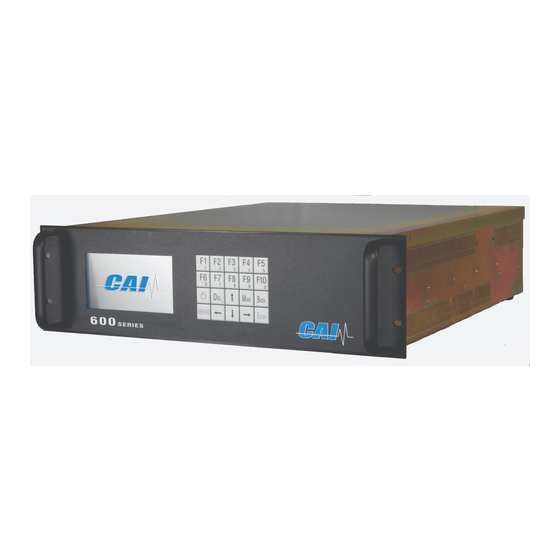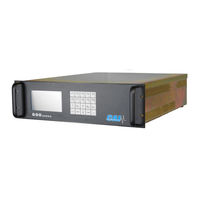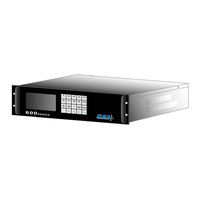
CAI 600 Series Manuals
Manuals and User Guides for CAI 600 Series. We have 4 CAI 600 Series manuals available for free PDF download: User Manual
CAI 600 Series User Manual (153 pages)
Total Hydrocarbon Analyzer
Brand: CAI
|
Category: Measuring Instruments
|
Size: 7 MB
Table of Contents
-
Introduction16
-
Overview16
-
Features21
-
Description21
-
Ranges22
-
Calibration22
-
Installation25
-
General25
-
Electrical26
-
Filtration29
-
Condensation29
-
Alarms33
-
Deviations34
-
Calibration34
-
Keypad36
-
Enter Key36
-
Main Menu42
-
Menus47
-
Deviations67
-
F5 Setup76
-
F1 Times77
-
Alarms82
-
F5 Password84
-
F7 Autostart89
-
F10 Version91
-
F7 Standby92
-
F8 Ignition93
-
Flow System94
-
Rear Panel96
-
Operation103
-
Startup103
-
Troubleshooting105
-
Error Messages107
-
Glossary108
-
Abs Deviations108
-
Lin. Value108
-
Measured Curve108
-
Measured Value108
-
Real Time109
-
Raw Value109
-
Status Line109
-
Scans111
-
Possible States112
-
ARMU: Raw Value113
-
ADRU: Pressures113
-
ADUF: Flows114
-
Control Commands116
-
SRES: Reset116
-
SPAU: Pause116
-
STBY: Standby116
-
SHCG: Cutter off117
-
SCH4: Cutter on117
-
Settings118
-
Appendix120
-
Connectors120
Advertisement
CAI 600 Series User Manual (110 pages)
CLD/O2
Brand: CAI
|
Category: Analytical Instruments
|
Size: 3 MB
Table of Contents
-
2 Features
12 -
-
General14
-
Electrical15
-
Gases16
-
-
-
Select Range28
-
-
-
F5 Setup36
-
F8 Standby50
-
-
Rear Panel51
-
-
9 Operation
59 -
-
-
Flow System61
-
Relay Board61
-
-
-
NO Converter67
CAI 600 Series User Manual (86 pages)
Gas Analyzer
Brand: CAI
|
Category: Measuring Instruments
|
Size: 3 MB
Table of Contents
-
2 Features
17-
Description17
-
Electronics20
-
-
-
General22
-
Electrical22
-
Gases23
-
-
-
-
F5 Setup40
-
F1 Times41
-
F4 Alarms43
-
F5 Password43
-
-
F8 Standby52
-
-
Rear Panel53
-
-
9 Operation
59 -
-
-
-
-
ADUF: Flows78
-
Settings83
Advertisement
CAI 600 Series User Manual (115 pages)
CLD
Brand: CAI
|
Category: Measuring Instruments
|
Size: 5 MB
Table of Contents
-
-
-
Descriptions11
-
Features11
-
-
-
Main Menu21
-
-
7 Main Menu
22-
F5 Setup30
-
F5 Password34
-
F8 Standby42
-
9 Operation
51 -
-
AK Protocol55
-
-
Introduction76
-
-
-
-
Over Range94
-
Zero94
-
Range Limits96
-
Span Values96
-
-
-
Offset & Gain100
-
Advertisement



